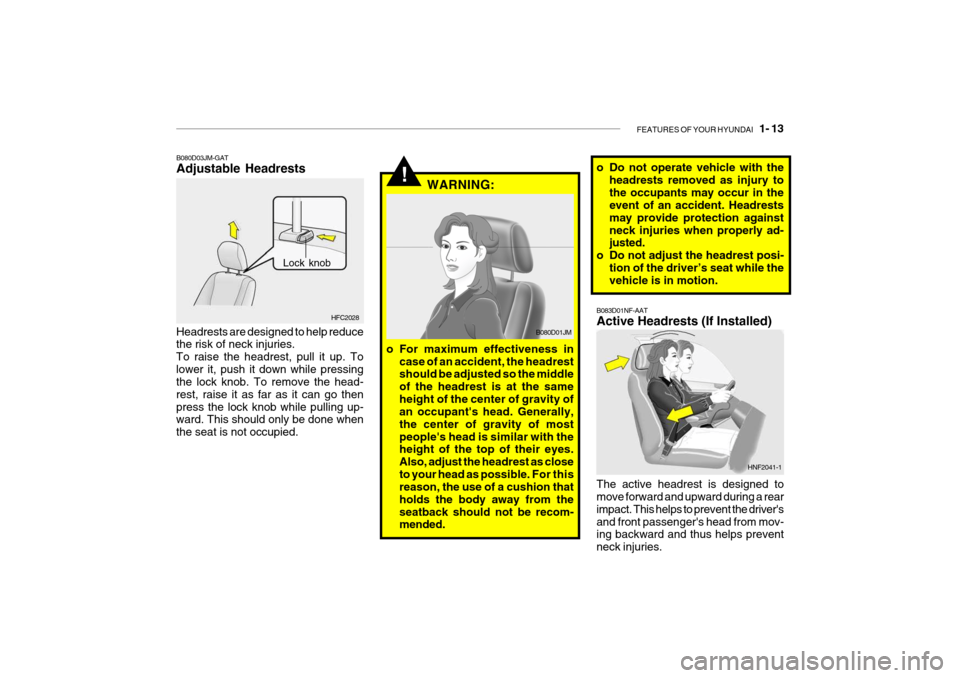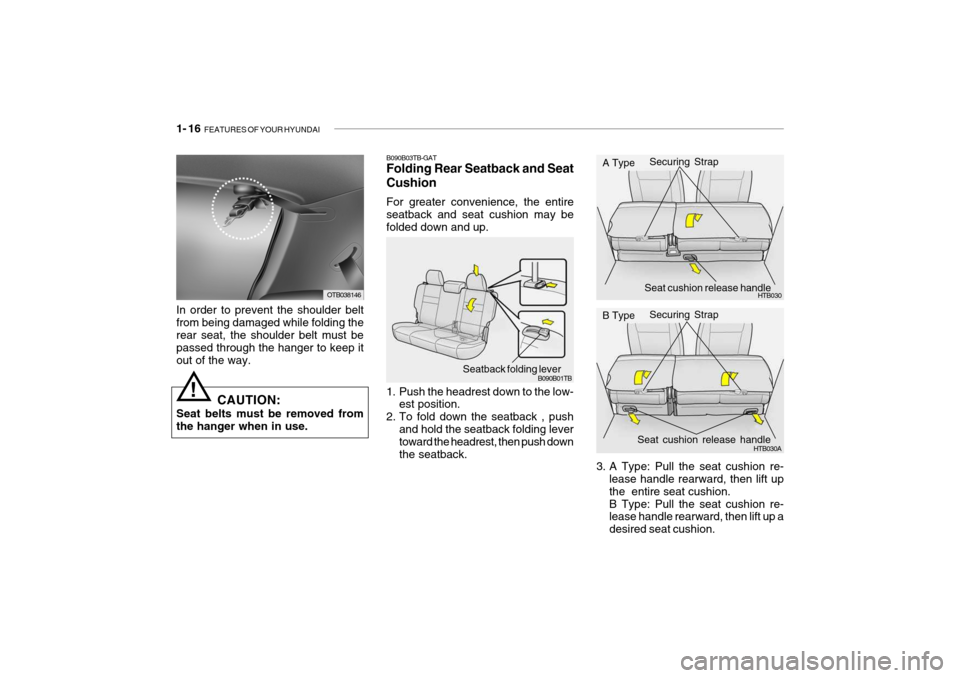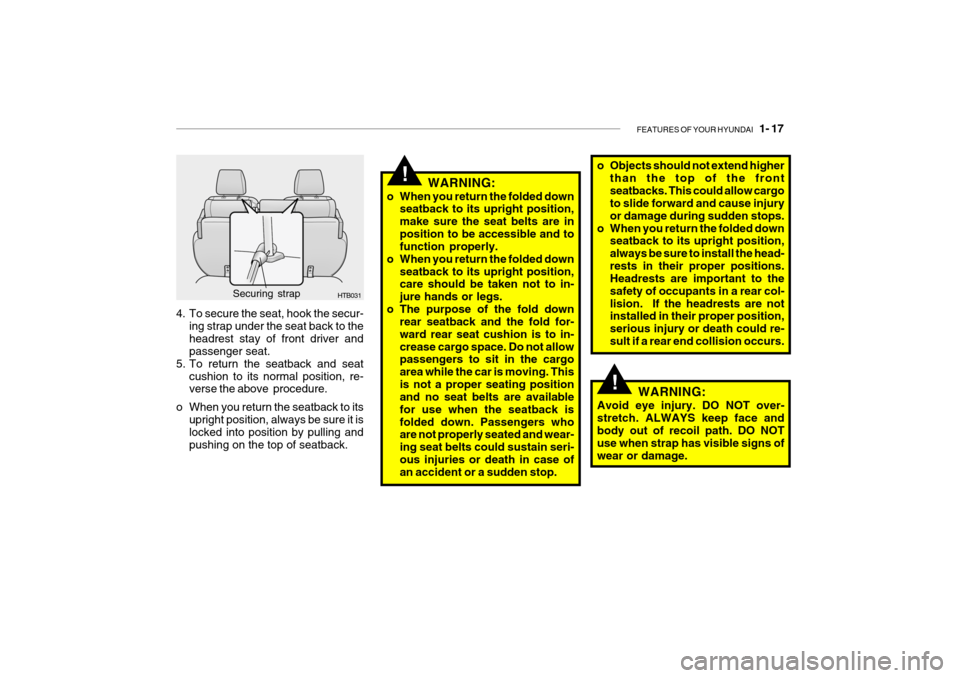2009 Hyundai Getz headrest
[x] Cancel search: headrestPage 24 of 191

FEATURES OF YOUR HYUNDAI 1- 13
HFC2028
Lock knob
!WARNING:
B080D03JM-GAT Adjustable Headrests
Headrests are designed to help reduce the risk of neck injuries. To raise the headrest, pull it up. Tolower it, push it down while pressing the lock knob. To remove the head- rest, raise it as far as it can go thenpress the lock knob while pulling up- ward. This should only be done when the seat is not occupied. B080D01JM
o For maximum effectiveness in case of an accident, the headrest should be adjusted so the middle of the headrest is at the sameheight of the center of gravity of an occupant's head. Generally, the center of gravity of mostpeople's head is similar with the height of the top of their eyes. Also, adjust the headrest as closeto your head as possible. For this
reason, the use of a cushion thatholds the body away from theseatback should not be recom- mended. o Do not operate vehicle with the
headrests removed as injury to the occupants may occur in the event of an accident. Headrests may provide protection againstneck injuries when properly ad- justed.
o Do not adjust the headrest posi- tion of the driver’s seat while thevehicle is in motion.
B083D01NF-AAT Active Headrests (If Installed) The active headrest is designed to move forward and upward during a rear impact. This helps to prevent the driver'sand front passenger's head from mov- ing backward and thus helps prevent neck injuries. HNF2041-1
Page 27 of 191

1- 16 FEATURES OF YOUR HYUNDAI
3. A Type: Pull the seat cushion re-
lease handle rearward, then lift up the entire seat cushion.B Type: Pull the seat cushion re- lease handle rearward, then lift up a desired seat cushion.
A Type B Type HTB030
Seat cushion release handle
HTB030A
Seat cushion release handle
Securing Strap Securing Strap
B090B01TBSeatback folding lever
B090B03TB-GAT Folding Rear Seatback and Seat Cushion For greater convenience, the entire seatback and seat cushion may be folded down and up.
1. Push the headrest down to the low-
est position.
2. To fold down the seatback , push and hold the seatback folding lever toward the headrest, then push down the seatback.
!
In order to prevent the shoulder belt from being damaged while folding therear seat, the shoulder belt must be passed through the hanger to keep it out of the way.
CAUTION:
Seat belts must be removed fromthe hanger when in use.
OTB038146
Page 28 of 191

FEATURES OF YOUR HYUNDAI 1- 17
!
WARNING:
o When you return the folded down seatback to its upright position, make sure the seat belts are inposition to be accessible and to function properly.
o When you return the folded down seatback to its upright position,care should be taken not to in- jure hands or legs.
o The purpose of the fold down rear seatback and the fold for-ward rear seat cushion is to in-crease cargo space. Do not allow passengers to sit in the cargo area while the car is moving. Thisis not a proper seating position and no seat belts are available for use when the seatback isfolded down. Passengers who are not properly seated and wear- ing seat belts could sustain seri-ous injuries or death in case of an accident or a sudden stop. o Objects should not extend higher
than the top of the front seatbacks. This could allow cargo to slide forward and cause injury or damage during sudden stops.
o When you return the folded down seatback to its upright position,always be sure to install the head-rests in their proper positions. Headrests are important to the safety of occupants in a rear col-lision. If the headrests are not installed in their proper position, serious injury or death could re- sult if a rear end collision occurs.
4. To secure the seat, hook the secur-
ing strap under the seat back to the headrest stay of front driver and passenger seat.
5. To return the seatback and seat
cushion to its normal position, re-verse the above procedure.
o When you return the seatback to its upright position, always be sure it is locked into position by pulling andpushing on the top of seatback.
HTB031Securing strap
!
WARNING:
Avoid eye injury. DO NOT over- stretch. ALWAYS keep face andbody out of recoil path. DO NOT use when strap has visible signs of wear or damage.
Page 98 of 191

DRIVING YOUR HYUNDAI 2- 3
!
C020A03S-DAT BEFORE STARTING THE EN- GINE Before you start the engine, you should always:
1. Look around the vehicle to be sure
there are no flat tyres, puddles of oil or water or other indications of pos- sible trouble.
2. After entering the car, check to be sure the parking brake is engaged.
3. Check that all windows, and lights are clean.
4. Check that the interior and exterior
mirrors are clean and in position.
5. Check your seat, seatback and headrest to be sure they are in theirproper positions.
6. Lock all the doors.
7. Fasten your seat belt and be sure
that all other occupants have fas- tened theirs.
8. Turn off all lights and accessories
that are not needed.
9. When you turn the ignition switch to "ON' check that all appropriatewarning lights are operating andthat you have sufficient fuel.
10.Check the operation of warning lights
and all bulbs when key is in the "ON"position. WARNING:
Always wear appropriate shoes whenoperating your vehicle. Unsuitable shoes (high heels, ski boots, etc.) may interfere with yourability to use the brake and accelera- tor pedal, and the clutch (if installed). C030A01A-GAT COMBINATION IGNITION SWITCHTo Start the Engine
o If your Hyundai is equipped with a
manual transaxle, place the shift lever in neutral and depress theclutch pedal fully.
o If your Hyundai has an automatic
transaxle, place the shift lever in "P"(park).
o To start the engine, insert the igni-
tion key and turn it to the "START"position. Release it as soon as the engine starts. Do not hold the key in the "START" position for more than15 seconds.
NOTE: For safety, the engine will not start if the shift lever is not in "P" or "N"Position (Automatic transaxle).
!WARNING:
When you intend to park or stop the vehicle with the engine on, be care- ful not to depress the accelerator pedal for a long period of time. It mayoverheat the engine or exhaust sys- tem and cause fire.
Page 189 of 191

INDEX 10- 3
Drink Holder ................................................................ 1-54
Drive Belts .................................................................. 6-18
Driving Economical driving .................................................. 2-14
Smooth corneri ng ..................................................... 2-15
Winter driving ........................................................... 2-15
E Emission Contro l System ............................................ 7-2
Engine Before starting the engine ........................................ 2-3Compartment ............................................................ 6-2
Coolant ..................................................................... 6-6
Coolant temperature Indicator ..................................1-41
If the engine overheats ............................................. 3-4
Number ..................................................................... 8-2
Oil ............................................................................. 6-4Starting ..................................................................... 2-4
Engine Exhaust Can Be Dangerous ............................ 2-2
F
Fan Speed Control ...................................................... 1-72
Fog Light
Front ........................................................................ 1-51
Front Seats Adjustable front seats .............................................. 1-12Adjustable headrests
............................................... 1-13
Adjusting seat forward and rearward ........................1-12
Adjusting seatback angle .. ......................................1-12
Lumbar support control ............................................ 1-14
Seat cushion height adjustment .............................. 1-14
Fuel
Capacity ................................................................... 9-2
Gauge ...................................................................... 1-41
recommendations ...................................................... 1-2
Fuel Filler Lid Remote release ....................................................... 1-63
Fuses ......................................................................... 6-18
Fuse panel Description ............................................... 6-30
GGeneral Checks ........................................................... 6-4
Glove Box .................................................................. 1-58
H Hand Brake ................................................................. 1-61
Hazard Warning System ............................................. 1-50
Headlight Aiming Adjustment...................................... 6-23
Heating and Cooling Control .......................................1-71
Air flow control ......................................................... 1-73
Air intake control ..................................................... 1-73
Bi-level heati ng ........................................................ 1-76
Fan speed control .................................................... 1-72
Temperature control ................................................. 1-75